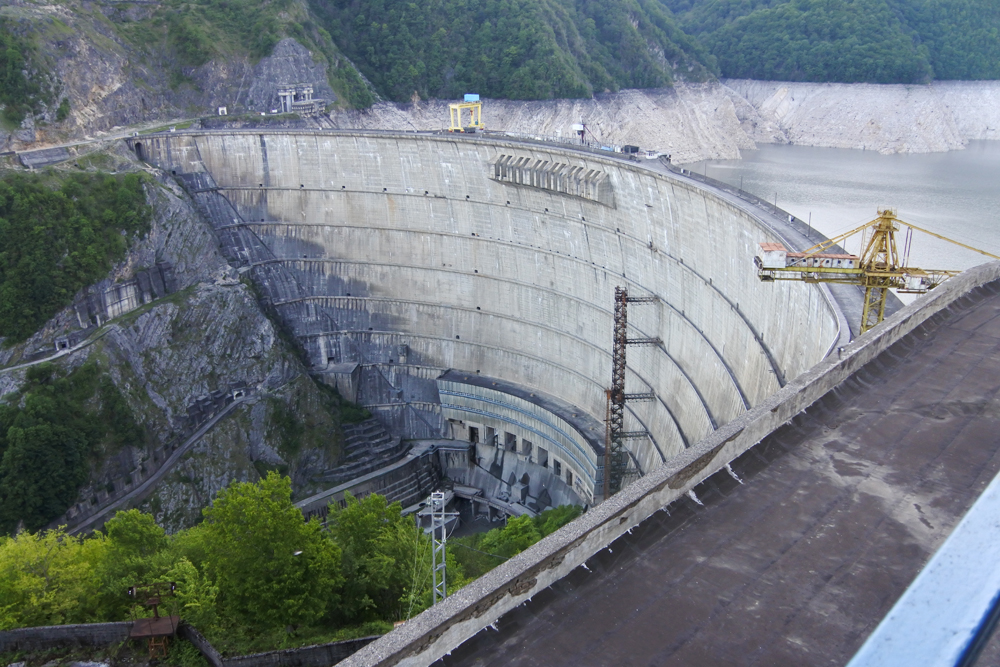Dams and Seismicity – Technologies for the safe and efficient operation of water reservoirs (DAMAST)
New dams are being built worldwide as part of the creation of a climate-friendly energy supply. In many places, natural or induced earthquakes, especially in combination with other extreme events such as heavy precipitation or landslides, are jeopardising the safety of dams and thus local populations. In the DAMAST project , German, Georgian and Armenian partners are examining the underlying processes as well as safety-relevant parameters of water reservoirs using the example of the Enguri Dam in the Caucasus. The project will develop transferable monitoring concepts for dams in tectonically active regions.

Figure 1: The 277m high arch dam of the Enguri dam in Georgia (Photo: AWG/KIT).
Safe and efficient power and water supply from dams
Many dams are located in seismically active regions worldwide. Even if the technical facilities are designed for such events, seismic activity in the immediate vicinity, so-called induced seismicity, can be triggered by operating activities on water reservoirs, endangering the population. For example, a 2008 earthquake in China, with more than 80,000 dead, is attributed to the filling of a large dam. Particular risk is caused by the simultaneous occurrence of several extreme events. For example, the combination of earthquakes, landslides or heavy precipitation with the unfavourable distribution of sediments in the water reservoir can lead to a sudden mobilisation and displacement of the sediments in the reservoir. This can lead to strain and possibly damage to dam walls
The DAMAST project aims to make a contribution to the systematic reduction of hazards at water reservoirs as well as to their long-term and efficient operation. The objective is to develop monitoring concepts that can also be transferred to other dams in comparable locations. The project will be implemented using innovative methods for the collection and analysis of relevant data.
CEDIM is a partner in the BMBF joint project, which is coordinated at KIT by the Institute of Applied Geosciences and in which several KIT institutions are involved. The research part of the CEDIM is dedicated to the conception of a modular early warning system by carrying out a hazard analysis for various extreme events or critical impact factors at the reservoir and integrating information from the monitoring systems set up with regard to the relevant key parameters. At the end of this project phase, the understanding of the process and the results of the monitoring should show whether and how improved risk management, including an early warning system to support decision-making, can be implemented by the end of phase III.
The following work packages are relevant in the first phase and will be interdisciplinary addressed by IMK-TRO, GPI and IKET :
- Statistical precipitation analysis in the context of climate change
In the first part, a hazard analysis of the heavy precipitation in the region around the dam will be carried out. In addition to a suitable definition of extreme heavy precipitation events oriented to the climatological context, this includes extensive statistical analyses. In addition, the effects of past dry and wet periods on the region and the dam will be investigated. Since climate change is expected to change the statistical distribution of precipitation probabilities and – in some regions – also the precipitation regime, it will be further investigated how these properties will develop in the future.
- Estimation of the hazard from various extreme events
In the second part, a holistic and comparative hazard analysis is carried out by including further relevant extreme events or their statistical probability of occurrence (hazard; e.g. earthquakes, unplanned load changes or sediment transport, inflow regimes, landslides as far as available).
- Concept for a modular early warning system
At first, the results obtained so far by all project participants will be collected (risk assessment, identification of key parameters through monitoring, cascade effects, suitable monitoring measures) and converted into a simplified prototype (drafting of an initial monitoring concept for the relevant processes). It is important to sufficiently consider the different time scales of the relevant processes. For example, information on short-term hazards such as earthquakes must be processed differently than information on longer-term factors that lead to hazards (e.g. sediment transport, etc.).
See also:
https://www.bmbf-client.de/projekte/damast
https://www.damast-caucasus.de

